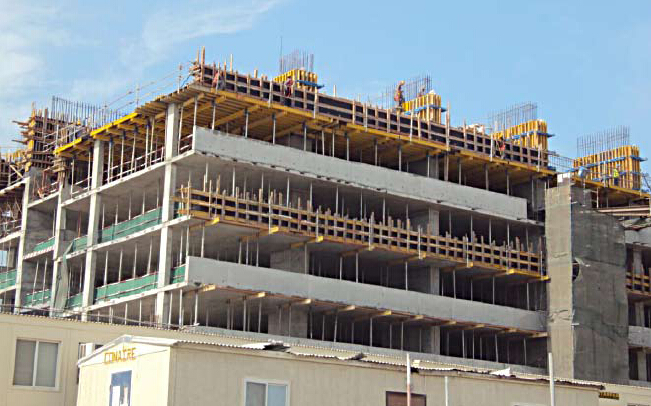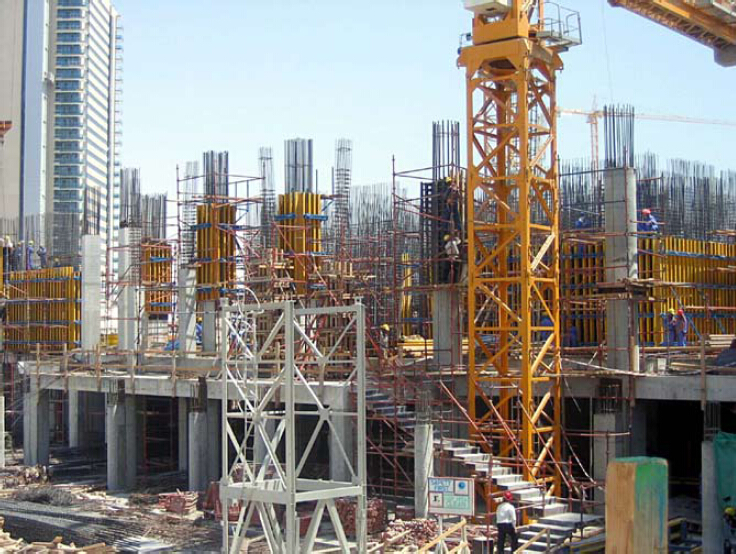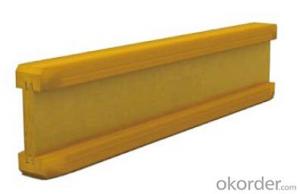Timber-Beam for formwork and scaffolding system
- Loading Port:
- Tianjin
- Payment Terms:
- TT OR LC
- Min Order Qty:
- 50 m²
- Supply Capability:
- 1000 m²/month
OKorder Service Pledge
OKorder Financial Service
You Might Also Like
Characteristics:
◆ Standardized production lines.
Supply capability: 3000m/day, Lmax = 6600mm.
◆ Finger jointing of the flange and web, the strength of timber beam is highly improved.
Max. shearing force failure load:40KN
◆ Well treated to prevent from water penetration or erosion, so the service life maximally extended.
Normally, CNBM timber beam H20 can be used for 4 to 5 years, the exact using time would depend on maintenance & storage.
◆ Robust caps at the end of the girders protect against damages.


- Q: How does steel formwork contribute to the overall stability of the structure?
- Steel formwork contributes to the overall stability of a structure in several ways. Firstly, steel is a highly durable and strong material, making it capable of withstanding significant loads and pressures. This strength ensures that the formwork remains intact and stable during the construction process, even when exposed to heavy loads such as wet concrete. Secondly, steel formwork provides excellent dimensional stability. Unlike other materials like wood, steel does not warp or deform over time, ensuring that the structure maintains its desired shape and dimensions. This is crucial for the stability of the structure, as any deformation or movement in the formwork could lead to inaccuracies or weaknesses in the final construction. Moreover, steel formwork offers a high level of rigidity and stiffness. This rigidity helps to prevent any unwanted movement or shifting of the formwork during concrete pouring and curing, ensuring that the structure is built according to the intended design and specifications. It also helps distribute the weight and forces evenly, reducing the risk of structural failures or collapses. Additionally, steel formwork provides excellent support and reinforcement for the concrete. The steel panels and beams used in formwork act as a framework, holding the concrete in place until it hardens and gains its own strength. This support not only ensures the proper formation of the structure but also enhances its overall stability by preventing any concrete cracking or failure. Lastly, steel formwork is highly adaptable and can be easily customized to fit various architectural designs and construction requirements. This flexibility allows for the creation of complex and unique structures, while still maintaining stability and strength. In conclusion, steel formwork contributes significantly to the overall stability of a structure through its durability, dimensional stability, rigidity, support, and adaptability. Its robustness and ability to withstand heavy loads, combined with its ability to maintain shape and provide structural support, make it an essential component in ensuring the stability and integrity of any construction project.
- Q: How long does steel formwork last?
- Various factors, including the quality of the steel used, the frequency and type of usage, and the maintenance practices employed, can affect the lifespan of steel formwork. Typically, steel formwork is renowned for its durability and longevity, and with proper maintenance, it can endure for numerous years or even decades. When steel formwork is consistently maintained and handled correctly, it can endure multiple uses and continue to function effectively. However, it is important to acknowledge that over time, steel formwork may experience wear and tear due to constant exposure to concrete, which can result in surface corrosion or deterioration. To address this, protective coatings can be applied or the formwork can be cleaned after each use. Moreover, external factors like environmental conditions and the type of concrete used can also impact the lifespan of steel formwork. Exposure to harsh weather conditions or chemicals can expedite the corrosion process, potentially reducing the formwork's lifespan. To ensure the durability of steel formwork, it is crucial to invest in high-quality steel with proper anti-corrosion properties, conduct regular inspections, and perform necessary maintenance and repairs as required. By adhering to these practices, steel formwork can endure for a significant period, making it a cost-effective and dependable choice for construction projects.
- Q: What are the common design considerations for steel formwork in hot climates?
- When designing steel formwork for utilization in hot climates, there are various common factors that must be considered. 1. Thermal Expansion: Steel possesses a high coefficient of thermal expansion, implying that it expands and contracts with temperature fluctuations. In hot climates, where temperatures can reach exceptionally high levels, it is crucial to account for this expansion in the formwork's design. Sufficient provision for expansion joints and allowances should be made to accommodate the thermal movement of the steel. 2. Heat Resistance: Steel formwork should be designed to endure elevated temperatures without experiencing significant deformation or loss of strength. This may involve the selection of steel grades with superior heat resistance or the implementation of additional cooling measures to prevent overheating. 3. Corrosion Protection: Hot and humid climates can expedite the corrosion process, necessitating the incorporation of effective corrosion protection measures in the design. This can be achieved through the utilization of corrosion-resistant coatings, such as galvanization or epoxy coatings, or by integrating sacrificial anodes to safeguard the steel against corrosion. 4. Ventilation: Hot climates typically necessitate adequate ventilation to prevent the accumulation of heat and moisture within the formwork. Appropriately designed openings and vents should be included to facilitate air circulation and avert the formation of condensation, which can lead to corrosion and diminish the formwork's lifespan. 5. Insulation: In exceedingly hot climates, insulation can assist in minimizing the transfer of heat to the formwork, thereby reducing the impact of thermal expansion and diminishing the risk of deformation. Insulation materials, such as foam or reflective coatings, can be employed to create a barrier between the steel formwork and the external environment. 6. Durability: The design of steel formwork should account for the long-term durability requirements of the project. This includes the selection of materials and construction methods that exhibit resistance to degradation caused by UV radiation, extreme temperatures, and other environmental factors commonly encountered in hot climates. In summary, the design of steel formwork for use in hot climates necessitates careful consideration of thermal expansion, heat resistance, corrosion protection, ventilation, insulation, and durability. By addressing these factors, the formwork can endure the challenges posed by hot climates and ensure the successful completion of construction projects.
- Q: What are the different types of formwork corner solutions used in steel formwork?
- There are several different types of formwork corner solutions used in steel formwork, each with its own advantages and suitability for different construction projects. Some of the common types include: 1. Internal Corner Solutions: These are used to create 90-degree internal corners in the formwork. They often consist of corner brackets or angle brackets that are attached to the steel formwork panels. These brackets provide stability and support to the formwork system, ensuring that the concrete is poured accurately and without any leakage. 2. External Corner Solutions: These are used to create 90-degree external corners in the formwork. They typically consist of corner brackets or external corner connectors that are attached to the steel formwork panels. These connectors provide stability and reinforcement to the formwork system, ensuring that the concrete is poured accurately and without any leakage. 3. Adjustable Corner Solutions: These are used to create corners of varying angles in the formwork system. They often consist of adjustable corner brackets or connectors that can be adjusted to the desired angle. These solutions are particularly useful when constructing structures with irregular or non-standard angles. 4. Corner Chamfer Solutions: These are used to create chamfered corners in the formwork system. They typically consist of chamfer strips or corner chamfer connectors that are attached to the steel formwork panels. These solutions allow for the creation of beveled edges in the concrete, giving a more aesthetically pleasing finish to the structure. 5. Corner Formwork Solutions: These are specially designed formwork systems that are specifically used for creating corners in the construction project. They often consist of pre-fabricated corner panels or corner formwork molds that can be easily assembled on-site. These solutions provide a quick and efficient way to create corners in the formwork system, saving time and labor. Overall, the choice of formwork corner solution depends on the specific requirements of the construction project, including the desired corner angle, the complexity of the structure, and the desired finish. It is important to carefully evaluate the different options and select the most suitable solution to ensure a successful and efficient construction process.
- Q: Can steel formwork be used for both reinforced and non-reinforced concrete structures?
- Absolutely! Steel formwork is applicable to both reinforced and non-reinforced concrete structures. This flexible and long-lasting choice can endure the immense pressure generated by the concrete during pouring. Moreover, it can be effortlessly put together and taken apart, making it ideal for diverse construction undertakings. Whether it's a reinforced structure necessitating supplementary reinforcement bar support or a non-reinforced structure requiring a temporary mold, steel formwork proves effective in either scenario. Its robustness and steadiness enable the achievement of accurate shapes and measurements, guaranteeing the desired result for any concrete structure.
- Q: How does steel formwork affect the overall project budget?
- Steel formwork can have a significant impact on the overall project budget. While steel formwork may have a higher initial cost compared to other types of formwork, such as timber or plywood, it offers several advantages that can ultimately lead to cost savings. One of the main advantages of steel formwork is its durability. Steel is a strong and long-lasting material, capable of withstanding the wear and tear of multiple uses. This means that steel formwork can be reused for numerous projects, reducing the need for frequent replacements and lowering costs in the long run. Furthermore, steel formwork allows for faster construction times. Its robustness and stability enable contractors to pour concrete at a faster rate, reducing labor costs and streamlining the construction process. Additionally, steel formwork can be easily assembled and disassembled, resulting in quicker turnaround times between projects. In terms of quality, steel formwork ensures a high level of precision and consistency in concrete structures. This can minimize the need for rework and corrections, thus reducing costs associated with fixing errors or imperfections. Moreover, steel formwork offers flexibility in design. It can be customized to fit various shapes and sizes, allowing for greater architectural freedom and creativity. This versatility can contribute to cost savings by eliminating the need for expensive and complex modifications to the formwork system. Finally, steel formwork is known for its resistance to moisture and weather conditions. Unlike timber or plywood, steel does not warp or deteriorate when exposed to moisture, which can result in cost savings by avoiding replacements or repairs due to water damage. In summary, while steel formwork may have a higher initial cost, its durability, reusability, speed, precision, flexibility, and resistance to environmental factors can lead to overall cost savings throughout the project. By considering the long-term benefits and efficiencies offered by steel formwork, project budgets can be effectively managed and optimized.
- Q: Can steel formwork be used for single-sided formwork applications?
- Yes, steel formwork can be used for single-sided formwork applications. Steel formwork is known for its durability and strength, making it suitable for various construction projects, including single-sided formwork. Single-sided formwork is commonly used when only one side of the concrete structure is accessible, such as when constructing retaining walls, columns, or beams against existing structures. Steel formwork provides the necessary support and stability to hold the concrete in place until it cures and hardens. It offers a high level of accuracy and precision, ensuring that the concrete structure is formed correctly and meets the desired specifications. Steel formwork can be easily assembled and disassembled, allowing for efficient and quick construction. Additionally, steel formwork can be reused multiple times, making it a cost-effective option for single-sided formwork applications. Overall, steel formwork is a reliable and suitable choice for single-sided formwork applications due to its strength, durability, accuracy, and efficiency.
- Q: How does steel formwork affect the overall dimensional stability of a structure?
- The overall dimensional stability of a structure can be significantly improved by using steel formwork. Steel formwork is known for its strength and rigidity, which makes it an excellent support system during construction. This ensures that the concrete is accurately and precisely placed, resulting in a structure with enhanced dimensional stability. There are several advantages to using steel formwork that contribute to its overall dimensional stability. Firstly, steel has a high strength-to-weight ratio, allowing for the creation of strong and durable formwork systems. This strength prevents any shifts or movements in the formwork during concrete pouring, reducing the likelihood of dimensional changes in the final structure. Furthermore, steel formwork offers superior dimensional accuracy compared to other materials. The steel plates or panels used in the formwork can be manufactured with high precision, resulting in consistent dimensions and smooth surfaces. This eliminates any inconsistencies or irregularities that may occur with traditional formwork materials like wood or plywood, further enhancing the overall dimensional stability. In addition, steel formwork is highly resistant to moisture, humidity, and temperature variations, which can cause dimensional changes in other materials. This resistance ensures that the formwork remains stable and maintains its original shape, even in challenging environmental conditions. The stability extends to the concrete poured within the formwork, as the steel helps to minimize shrinkage and expansion, reducing the risk of cracks or warping in the structure. In conclusion, steel formwork is essential for maintaining the overall dimensional stability of a structure. Its strength, precision, and resistance to environmental factors ensure that the formwork remains intact and accurately supports the concrete placement. By providing a reliable and robust framework, steel formwork allows for the creation of structures with enhanced dimensional stability, resulting in a long-lasting and durable final product.
- Q: Can steel formwork be custom-made?
- Yes, steel formwork can be custom-made. Steel is a versatile material that can be easily shaped and welded to create formwork that meets specific project requirements. Custom-made steel formwork is often used in construction projects where standard formwork systems may not be suitable due to unique design elements or complex geometries. By customizing the steel formwork, construction companies can ensure that it fits perfectly, resulting in efficient and accurate concrete pouring, reducing waste and saving time and costs. Custom-made steel formwork also offers the advantage of durability and reusability, providing long-term benefits for multiple construction projects.
- Q: How does steel formwork compare to plastic formwork in terms of cost and durability?
- Steel formwork generally tends to be more expensive than plastic formwork due to the higher cost of steel as a material. However, steel formwork offers better durability and longevity compared to plastic formwork. Steel can withstand heavy loads and repetitive use, making it more suitable for large-scale construction projects. While plastic formwork may be more cost-effective for smaller and temporary projects, steel formwork is a more cost-efficient and durable option for long-term use.
Send your message to us
Timber-Beam for formwork and scaffolding system
- Loading Port:
- Tianjin
- Payment Terms:
- TT OR LC
- Min Order Qty:
- 50 m²
- Supply Capability:
- 1000 m²/month
OKorder Service Pledge
OKorder Financial Service
Similar products
Hot products
Hot Searches
Related keywords





















